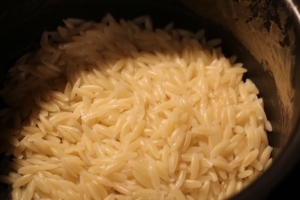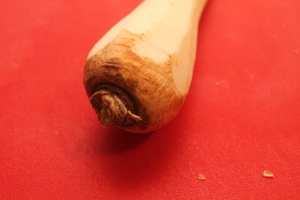I have posted pretty elaborate posts about what I try to feed Mattelyn and why. I know being so thoroughly detailed about my wishes to feed her “appropriately” (in my humble opinion) appears overwhelming at times but honestly, it is how I strive to provide for her on a daily basis so it is just a part of my job. And I always take my job seriously, with gusto, with deafening thoroughness and no matter what, giving 110% effort. Since this is by far the most important job I have ever, EVER had, one would expect none-the-less!
That said, I wanted to pass on this simple, warm cereal I make for Mattelyn every morning. And a lot of times, minus the banana, before bed, too. Although I am always researching and experimenting with different options for her meals, I also look to establish “go to meals” that make daily life a bit easier. There are certain things I can count on – and a staple like this cereal that she loves is one of them. This also makes it part of our routine – I know what to shop for at the store every week and no matter how busy I get that morning, because I have made this many times for her, I can do it one-handed, on the phone, letting the dog out, making her bottle, holding her while she is crying…
Plain oatmeal cereal for infants is a wonderful base because it is bland, easy to digest and full of iron – which is severely important for infants age 6-12 months (and really until 2 years of age). Iron is a nutrient that babies need for brain development, (among other important development), and the majority of the time, babies that are tested for iron are deficient or have iron-deficient anemia. This is a scary thought when it aids in BRAIN development. I only had to read that ONE TIME to recognize that she needed iron-rich breast milk, formula and baby cereal – and I had the power to give that to her every day throughout the day. This has become a personal quest of mine now – to feed her meals that are full of iron. This is an excerpt from the Baby Center Website that explains babies that are “at risk:”
Breastfed babies who receive no iron-fortified foods after 4 months of age. The iron in breast milk is absorbed three times better than the iron in formula, but around the time a baby starts eating solids, he needs additional iron in the form of fortified cereals and other iron-rich foods.
I am also very aware of GMOs (if you have read my other posts) when it comes to feeding Mattelyn. She was strictly breastfed for her first 6 months and when we introduced solid foods, I wanted to try my hardest to protect her from genetically modified organisms (GMOs) and genetically modified ingredients (GMIs). I am also a huge proponent of no preservatives – if I can make it myself, I control everything including the flavor of the food. Not to mention she will have a lifetime of eating preservatives and GMOs. GMOs and GMIs are not included on food labels. The only way you be positive you are buying food that has no GMOs or GMIs is by purchasing organic that specifically says that on the label. This is something that I want to do for her and feel strongly about. I understand at this point in her life, I can safeguard her in this way. You can read more about GMOs and GMIs in my other posts or Google it – it is a hot topic when it comes to baby formula. I use Earth’s Best for her formula and oatmeal cereal. You can also go to the Non GMO Project Website to read a lot more about the topic and for a list of baby food and baby formula that are non GMO (not to mention plenty of other products, foods, brands and retailers).

Peeled organic apples steaming on stove for 7 minutes. Then using a handheld Immersion Blender, create a puree.

Organic Apple Puree – freeze the ice cube tray and once they are frozen, pop out and place in Ziploc bags for daily use. Each cube is 3/4 – 1oz in size.
To make this cereal, I use:
- an ounce of fresh (or frozen fresh) apple puree,
- 1 tablespoon of Earth’s Best Organic Oatmeal Cereal,
- a quarter of a banana, cut into small pieces and mashed,
- 3-4 tablespoons of breast milk or baby’s daily formula.
It’s THAT EASY.
I make a 2 oz. bottle in the bottle warmer (2 oz of purified water plus one level, unpacked scoop of baby formula, shake, warm for 2 minutes and shake again) and I defrost one of the frozen apple puree “ice cubes” (melt in microwave for 15 seconds). Then, I mash 1/4 of a banana with a fork. Mix one tablespoon of the cereal with 3-4 tablespoons of breast milk or formula. Add the apple puree and add additional milk to make it the consistency your baby prefers. Then, add in the mashed banana.
This is wonderful, warm and it is filling for baby’s tummy. You can also change up the base fruit with pears or some other fruit puree. I also use prune puree if she is a bit constipated. She really likes apple and prune puree. Either way, this provides baby with two servings of fruit, whole grains and a lot of iron (in both the cereal and formula). It is an excellent way to boost their little metabolisms first thing every morning. And as an evening snack, it helps keep baby’s tummy full for the night. I leave out the banana because I feel she reacts to the natural sugar in the banana and gets an extra boost of energy right when I want her to settle down for story time!
You can also print this and keep it handy for grandparents or your baby’s care provider. These directions are easy to follow and anyone can do it.
I would love to hear how your little one enjoys this and hear different morning dishes you routinely make! I would also just like to hear from YOU! Follow me here, on Twitter, Instagram – I will follow you back. I am new to this and looking to share information and IDEAS.
Happy New Year! 2014 is going to be a fabulous year – I just know it! Full of so many changes within Mattelyn which in turn will be new experiences for me. Can’t wait!
XO – Stephanie






















